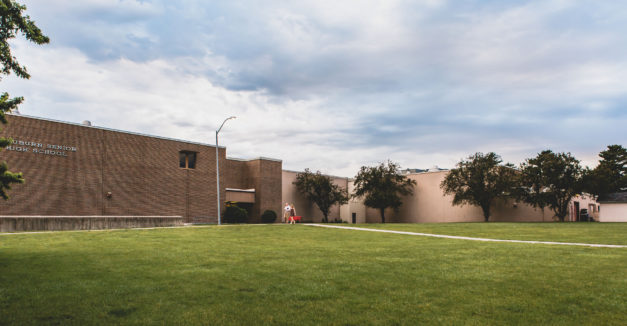This feature is part of the 2017 Good Living Tour storytelling project thanks to presenting sponsor the Nebraska Department of Economic Development and to generous support from Peter Kiewit Foundation, Nebraska Community Foundation, Humanities Nebraska,Nebraska Cultural Endowment, Pinnacle Bank, Nebraska Loves Public Schools, Union Pacific Railroad, Center for Rural Affairs, and the Nebraska Arts Council.
* * *
Several doors down the hallway from Kevin Reiman’s office inside the Auburn Consolidated School District building, you’ll find the space in which both the eighth grade basketball team and the high school competitive theater group hold practice. He jokingly calls it “the gymatorium,” but the phrase is spot-on: finished hardwood planks comprise the stage, with basketball hoops behind the curtains on either side, all before cramped metal and cloth seating.
The room doesn’t have heat or air conditioning, so it’s a little sweaty as Reiman makes his way stage front one warm May afternoon. It feels slightly more stifled as he describes various scenes: crowds of parents ebbing and flowing into the rows, kids with jackets on rehearsing for one-acts, hours and hours of holiday programming in a place built in 1938. This deficiency is indicative of the way Reiman feels the arts are currently treated in Auburn.
“You look at [other] opportunities we give kids and it’s an area that we don’t provide kids with an opportunity to excel,” Reiman says. The 20-year district employee and current superintendent is skilled at fundraising for special projects, earning a $250,000 grant for a greenhouse classroom for which he cut the ribbon in April 2017. He’s also a baseball coach and father of football players, facts that amount to a well-rounded perspective through which he can see a problem with the balance of resources invested into the arts.
“We have this football stadium that is top-notch,” he continues. “My kids played football, I’m not knocking it, but we provided a venue for them. We’ve worked hard on vocational programs, we have a venue for welding and metal. But for the musical, it’s here, and I’m looking at the kids doing these fantastic productions and [thinking] this is embarrassing that they’re performing in this venue.”
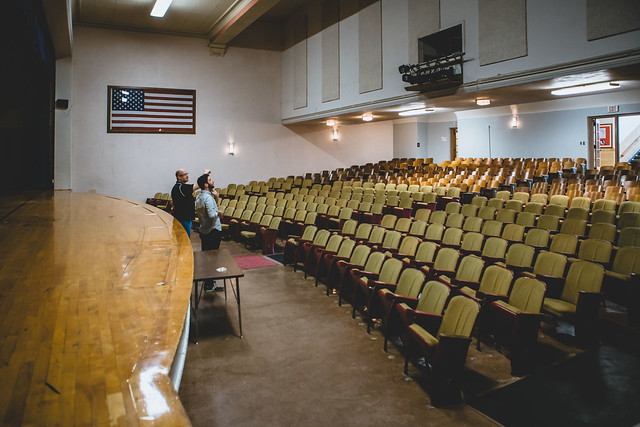
Auburn School District Superintendent Kevin Reiman shows off the “gymaotrium,” which serves as a practice and performance space for sports and activities alike. | photo by Lauren Farris
Later that evening, Reiman stood near the bleachers inside Auburn High School’s clean, cavernous gymnasium, speaking before a small crowd gathered for an arts-centric event hosted with Nebraska Loves Public Schools. The video documentary organization had premiered a 30-minute piece called Why The Arts Matter, in which art, theater and music teachers from across Nebraska explain first-hand the myriad ways in which their disciplines benefit their students. A handful of Auburn residents — including Auburn School District band and art teachers and a pair of students — all testified in support, their words echoing through the bleachers and piling atop a heaping portion of positivity.
When Reiman gave his own endorsement of the arts to that group and NET Nebraska’s television audience, it was tough not to recall our conversation in his office earlier that day. High school gymnasiums are not known for their acoustics — cheering and jeering work to the home team’s advantage when allowed to clang around the room in rampancy. But as the location in which the Auburn High School’s bands and choirs perform their bi-annual shows, the ones for which they practice and prepare all year, some say, the building is woefully inadequate.
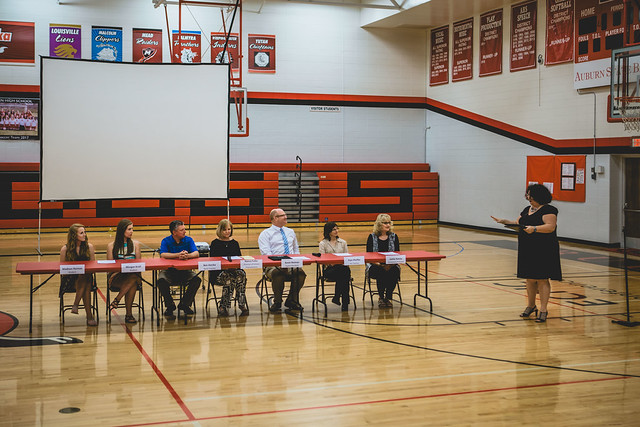
Several panelists, including Reiman (seated third from right), participate in an arts-support Nebraska Loves Public Schools event at Auburn High School in May 2017 | photo by Lauren Farris
* * *
Auburn High School opened in the 1970’s, the cafeteria’s north wall constructed with the intent to one day knock it out for a dedicated performing arts center addition. Such a building, in any iteration (and there are currently a handful of proposals) would house classrooms, lockers, rehearsal rooms and a dedicated performance space with the proper acoustics and seating to house top-quality, countywide events.
Decades later, that wall remains untouched, the town absent a place Reiman and others believe music students deserve. Various arts-positive groups, including a nonprofit advocacy group aptly titled The Performing Arts Center, have pushed to pass school bonds and raise private funds. In fact, an early-2017 City of Auburn survey compiled a “wishlist” via community survey of the public services residents wish to see completed, with a performing arts center at the top, next to a community sports facility.
Auburn residents have had this particular question placed in front of them twice within the past decade. In 2008, the county voted on three ballot measures: a brand new middle school, gymnasium practice space and a performing arts center. The first measure passed, allowing sixth through eighth graders to move to updated facilities (and the district to move into its current home at 1713 J St). Both the gym and PAC were defeated — the latter by eight votes. In May 2017, another ballot question failed nearly two to one.
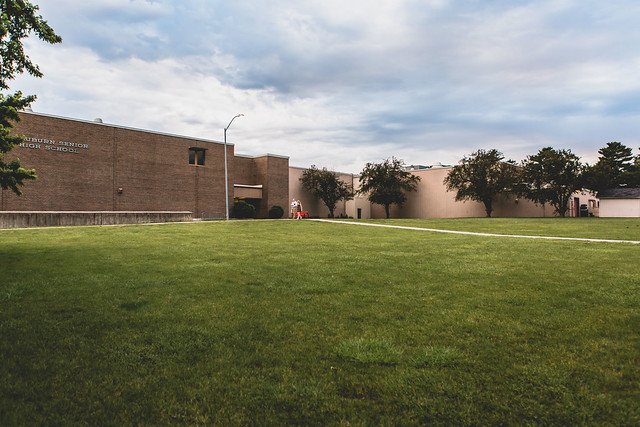
Auburn High School was built in the 1970’s with one of its cafeteria walls ready to replace with a performing arts center | photo by Lauren Farris
Pastor John Rathjen, who was in the audience during the NELPS video premiere, is part of the group currently tasking itself with raising money for a performing arts space in Auburn. In September 2013, he and a small group of colleagues revived the Performing Arts Center corporation, which started in 1996, as a 501(c)(3) nonprofit organization aimed at generating community and private support for a dedicated performing arts building.
Rathjen broke from vacation bible school preparation at Trinity Evangelical Lutheran Church, on the southeast corner of town, earlier that day to talk about the group’s endeavors. The Grand Island native graduated seminary in 1995, serving at a church in Hutchinson, Minn. (five hours west of downtown Minneapolis) before landing in Auburn in 2001.
In a small conference room, surrounded by boxes stuffed with educational materials, Rathjen speaks candidly about the organization’s small but earnest efforts and about his staunch belief in the ways students benefit from arts programs. He talks about his children: his daughter Heidi, who came out of her shell after joining choir her sophomore year, eventually scoring a lead role in a school play; and his son Micah, now at UNL, who swore he would never join show choir before ending up in the front row.
“It’s that kind of thing: giving people the opportunity that they and the people around them never would have never imagined,” Rathjen says. “To support and encourage that in a broader and more intentional way than we have in the past is part of our effort. It’s about more than just a brick and mortar facility.”
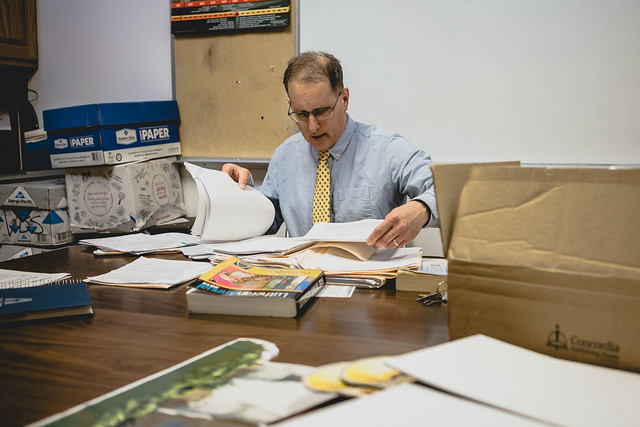
Pastor John Rathjen pours over records in the Trinity Evangelical Lutheran Church conference room. Rathjen leads the group trying to build a performing arts center in Auburn | photo by Lauren Farris
As the leader of a rural, far-reaching congregation, Rathjen says he has heard positions on both sides of the issue — one which hinges chiefly on funding. Hypothetically, he says, most people would be supportive of a dedicated music and arts space. But when it comes down to it, many balk at the estimated $6.5 million price tag.
“That was one of the things that has worked against us is people seeing that number and saying we cannot see the light at the end of the tunnel,” Rathjen says. “Getting people on board in terms of gifts has been a real challenge for us because people say ‘When is that ever going to happen?’”
Simply put, the PAC group has been unable to reach people in the way that would get the train moving. Those types of reactions have caused the group to step back and examine fundamental organizational tenants like mission statement and community outreach strategy. What can they do to help people see it their way?
One factor in their favor is precedent. The Performing Arts Center group uses The Tassle, located in Holdrege, Neb., as its model for both construction and, less formally, timeline. Gifted to Holdrege Public Schools in 1999 after more than a decade of private donations, it boasts 818 seats, a two-level lobby and auditorium system with elevator, dressing rooms, green rooms and a 100-by-34-foot stage.
“That’s what we wanted our facility to be was a community facility, not just a school district facility but one that would support the arts in our area in a broader way,” Rathjen says.
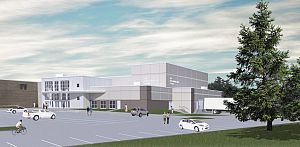
An artists rendering of one potential performing arts center building, which would be attached to Auburn High School. Commissioned by the PAC group, it would cost an estimated $6.5 million. | courtesy of the Performing Arts Center
A building of that magnitude would certainly accomplish PAC’s goal, but with its estimated $6.5 million cost, at least a chunk of the money would have to come from private donations. While a school bond remains possible, the two previous ballot initiatives failed. Reiman says that over the last two years, the Auburn School District has lost more than $1 million in state aid, or more than 10-percent of its operating budget. They have managed to avoid staff cuts, with some longer-term employees headed for retirement or other destinations. But the cuts still mean delayed activation on an improved $80,000 reading program and $100,000 for computer replacement.
To compare those numbers, Reiman’s $250,000 greenhouse project happened entirely because of grants. That amount of money alone is big for a capital project, but one that runs between $4 million — the school district’s estimate for a baseline facility that would serve students — and $6.5 million, private funding is necessary. Some have suggested renovating the gymatorium, but Reiman says that’s as good as waving the white flag.
He believes Auburn wants to see this happen, but many people simply see the bottom line on their taxes.
“[Auburn’s citizens] aren’t anti-education or anti-arts,” Reiman says. “[They’re] dealing with same problem as the unicameral. When ag-land spiked, the burden of funding education fell to that ag land and we can’t afford another 3-4-5 cents on our [taxes]. As much as we want this for you, [they say] ‘We’re tapped out.’”
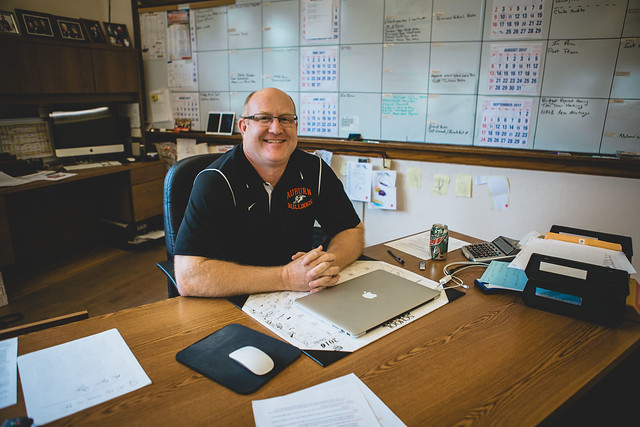
Auburn School District Superintendent Kevin Reiman sits at his desk. | photo by Lauren Farris
Despite these challenges, Reiman still lists a performing arts center as his top priority going forward. He has sat in on fundraising meetings and offered all but monetary support, but says in order for the school district to move on another ballot question, there would need to be some private money shown up front.
Auburn-native business owner Brent Comstock agrees. The young entrepreneur founded tech services company BCom Solutions when he was just 12 years old and continues to run it out of an expanded office suite near the very center of downtown.
As a student at Auburn High School (when Reiman was principal there), Comstock participated in one-act, state choir and speech, traveling to other, sometimes smaller schools with acoustically-sound facilities. He argues those types of settings improve the experience for rural arts students and has the potential to boost their confidence.
“Holy cow, I can line up with people who are going to prep schools,” Comstock says, reflecting on what he thought during those trips.
But Comstock identified more than just the arts-based and student-based benefits in building a performing arts center. Such a facility brings potential commercial value with the ability to host national touring and performing acts, political rallies, business conferences and town halls.
“If that space existed, I would be willing to rent that space out,” Comstock says.
Those types of events mean patrons dining in Auburn’s restaurants and staying in its hotels, things that spur the entire community. But in order to get people on board, Comstock says there needs to be some signal that the train is moving. That could mean one or a handful of capital investors who could use their monetary and human resources to help attract additional support — and perhaps a full or part-time fundraiser to make those connections. He notes the potential challenge in both regards, but adds that it’s the likeliest path to success.
“This is gonna take people to not only invest their pocketbooks, but to invest their time and energy,” Comstock says.
He adds, optimistically: “The arts is something that is important to our community.”
For his part, Rathjen is cautiously encouraged. The PAC recently received a small donation from the Auburn Jaycees organization, which he says has been a “kick in the pants” to their focus. The group — which meets quarterly in the spare time between work and family — has gathered a proposal and is working on ways to reach the community. He’s confident in the $6.5 million figure being the right one for students needs; with the right facilities, their year-round hard work can be recognized on what he sees as the proper stage.
Near the end of our chat, Rathjen reflects on the intangible benefits of the arts. A couple of years ago, he watched Auburn High School’s choir perform at an all-state competition, like one of the big ones Comstock mentioned. He says it’s “tough to nail down,” but the positive community-building aspect of that setting is indispensable.
“To go and hear them perform or to go to the all-state performance itself to hear the choir or jazz band,” Rathjen says. “It makes you step back and say ‘Wow.’”





